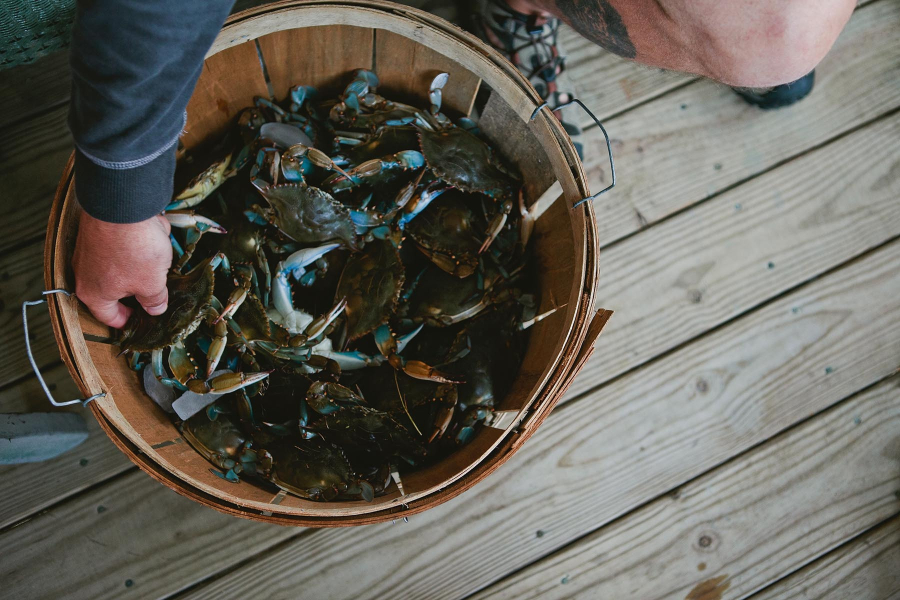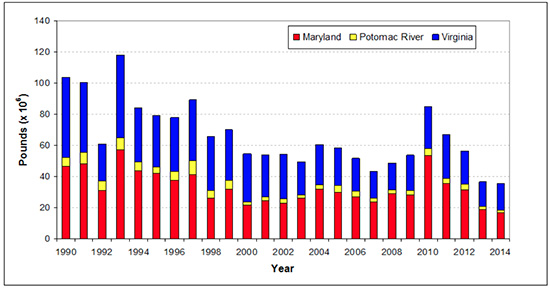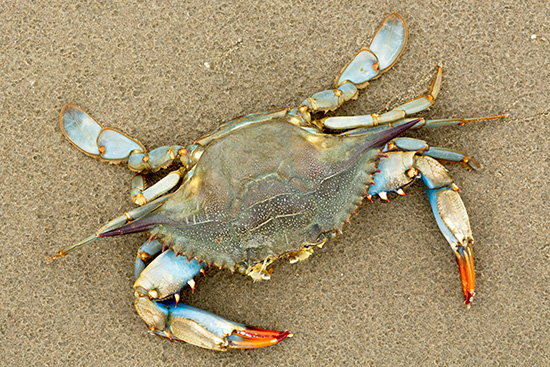By the Numbers: 35 million pounds
The Chesapeake Bay-wide commercial blue crab harvest recorded during the 2014 season

Blue crabs are one of the most recognized and oft-consumed species in the Chesapeake Bay. Watermen harvest the olive green, eight-legged crustacean with trotlines and crab pots so tourists and watershed natives alike can eat them at bars, restaurants and paper-covered picnic tables all summer long. But despite continued demand, the commercial harvest of blue crabs has dropped by two-thirds over the last two and a half decades.
Since 1990, commercial watermen have harvested more than 1.6 billion pounds of blue crabs from the Bay. Data show commercial harvest has experienced a steady decline, and last year hit the lowest level recorded in 25 years: 35 million pounds.

Why was harvest so low? “A combination of factors,” said Chesapeake Bay Stock Assessment Committee Coordinator Emilie Franke. One factor that often affects harvest is the set of regulations put in place to conserve the population. Last season, Maryland, Virginia and the Potomac River Fisheries Commission responded to relatively low blue crab abundance by putting additional commercial harvest regulations in place. But these regulations alone do not determine harvest levels. Low crab abundance can also lower harvest, making it harder for crabbers to catch crabs in the first place. In other words, the explanation could lay in the blue crab population and the host of factors that affect it.
The Chesapeake Bay Stock Assessment Committee (CBSAC) brings together scientists and representatives from the federal government, state governments and academic institutions. It meets each year to review the results of blue crab surveys and develop management advice.
“Chesapeake Bay blue crabs were considered depleted in 2014 due to low female abundance," Franke said. "But jurisdictions have harvested below the female exploitation target for seven consecutive years. So there are obviously other factors at play affecting population and harvest levels. A lot of these factors are things fishery managers can't control."

On the list? Natural variability, water quality, habitat quality, predator and prey abundance, disease, competition and overwintering mortality, all of which affect the amount of blue crabs in the Bay. (Overwintering mortality affected all segments of the blue crab population in 2015, for instance, and led to an estimated 15 percent drop in overall abundance.)
Tracking these factors—including those we can control—is critical to blue crab management. This is one reason accurate harvest reporting is so important. In its annual report on the status of the blue crab population, CBSAC recommended continued improvement in the quality of catch and fishing effort information submitted by commercial and recreational harvesters. Jurisdictions have explored new harvest technologies in recent years, and the Chesapeake Bay Watershed Agreement includes a commitment to improve harvest accountability.
The state of Maryland’s electronic harvest reporting pilot program is an example of new harvest reporting technology in action. While traditional paper-based reporting can be inefficient and prone to errors, electronic reporting can provide more timely, accurate and verifiable information to fishery managers.
“Increased harvest accountability provides managers with an accurate picture of the fishery, which helps inform future management decisions,” Franke said. “Getting a better understanding of catch and fishing effort is a big priority.”

Comments
There are no comments.
Thank you!
Your comment has been received. Before it can be published, the comment will be reviewed by our team to ensure it adheres with our rules of engagement.
Back to recent stories